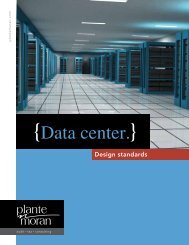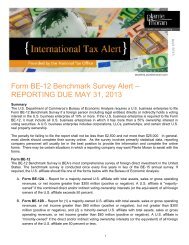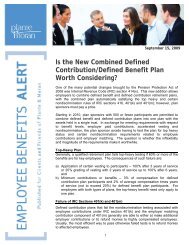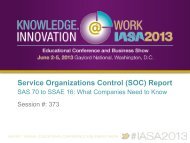Read full article. - Plante Moran
Read full article. - Plante Moran
Read full article. - Plante Moran
Create successful ePaper yourself
Turn your PDF publications into a flip-book with our unique Google optimized e-Paper software.
Published 2010 1<br />
IFRS is coming.<br />
Is Your Organization <strong>Read</strong>y?<br />
8 Proactive Steps Public Companies Should Be Doing Now<br />
By Mark zajac
8 Proactive Steps Public Companies Should Be Doing Now
Published 2010 1<br />
For those that have yet to hear the four-letter acronym, IFRS is short for International Financial Reporting Standards.<br />
Although the United States has yet to adopt the standard for domestic SEC registrants, it is the required or permitted<br />
accounting and financial reporting standard in more than 100 countries around the world. Since 2005, all public companies<br />
in the European Union (27 countries in total) have been required to use IFRS as their accounting backbone. Canada will be<br />
migrating to IFRS beginning in 2011.<br />
IFRS accounting standards are produced by the International Accounting Standards Board (IASB), similar to the Norwalk,<br />
Conn.-based Financial Accounting Standards Board (FASB). The IASB is headquartered in London, England and has been<br />
around in some form or another since 1973. IFRS accounting standards are principles-based, whereas U.S. GAAP is more<br />
rules-based. As a result, IFRS standards necessarily require increased interpretation and judgment in their application,<br />
along with additional disclosures. Critics of international accounting standards argue that there’s so much room for<br />
interpretation that users of these financial statements won’t be able to compare a company’s financial statements to one<br />
another, even within a single homogenous industry. Proponents of IFRS argue that a global set of standardized accounting<br />
rules will allow companies more diverse access to capital markets and allow organizations to be more capital-efficient and<br />
globally responsible.<br />
Because of the highly interpretive nature of IFRS and the increased amount of disclosures needed to comply with these<br />
standards, it’s in the best interests of SEC registrants to evaluate the key functional support areas and internal control<br />
environment to determine what effects a conversion of this magnitude will have on the sustainability of the company.<br />
Although some larger U.S.-based public companies may begin transitioning to IFRS in the near future, assuming the SEC’s<br />
Roadmap for the Adoption of IFRS includes an early application provision, most of these companies are a few years away<br />
from being required to implement the new standards. Regardless, organizations shouldn’t be sitting dormant and letting<br />
precious time elapse. Below are eight steps your organization can take to immediately gauge what key functional areas will<br />
need to be addressed once the SEC flips the switch to IFRS reporting in the United States.<br />
This IFRS <strong>article</strong> focuses on 8 steps public companies should be doing now<br />
Step 1: Perform a High-Level Financial Statement Review of the Impact of IFRS Adoption 2–3<br />
Step 2: Evaluate the Impact of IFRS Transition on Debt Covenants and Borrowing Facilities 4<br />
Step 3: Evaluate the Impact of Your Inventory Costing Method – No More LIFO? 5<br />
Step 4: Evaluate the Impact of IFRS Adoption on Compensation Policies 6<br />
Step 5: Evaluate Information Technology Systems and Processes 7<br />
Step 6: Involve Internal Audit Early 8<br />
Step 7: Evaluate Organizational IFRS Knowledge and Training Needs 9<br />
Step 8: Become Familiar with IFRS 1 — First-time Adoption Guidance 10
2<br />
8 Proactive Steps Public Companies Should Be Doing Now<br />
1<br />
Step One:<br />
a High-Level Financial Statement Review of the Impact of IFRS Adoption<br />
According to the 2007 Citigroup study of 73 large European companies with stock traded on U.S.<br />
exchanges as American Depository Receipts (ADRs), profits were on average 23 percent higher under<br />
IFRS than U.S. GAAP. Further, the study cited that 82 percent of firms reported higher profit figures<br />
under IFRS. Another study conducted by RG Associates of Baltimore, Md. similarly found 63 percent of<br />
organizations reporting higher profit numbers under IFRS.<br />
With such convincing statistics, it’s fair to expect that your organization could report a higher level<br />
of profits under IFRS than under U.S. GAAP. The magnitude of the change however, will depend<br />
heavily upon the nature of your entity’s operations and the elections made under IFRS. For example,<br />
as described below, IFRS provides for optional elections to account for property and equipment and<br />
intangibles using a “revaluation” model. Under a revaluation model, long-lived assets are periodically<br />
adjusted to fair value.<br />
Before reconciling your books to IFRS (even at a high level), perform some preliminary research. Prior<br />
to 2007, all non-U.S. based companies with stock traded on an exchange located in the United States<br />
(ADRs or ADSs) were required to reconcile their IFRS books to U.S. GAAP using SEC form 20-F (Foreign<br />
Annual Report) and show every reconciliation detail along the way. As a first step, consider finding an<br />
IFRS-reporting public foreign company with stock traded on a U.S. exchange that’s in your particular<br />
industry. Go back to years prior to 2007, and download their 20-F forms from the SEC website (sec.gov).<br />
Find the area of the report where the reconciliations are highlighted in detail, and compare and contrast<br />
the conversions you may have to make. This could be a great start starting point in highlighting some of<br />
the key issues your organization will face in adopting IFRS.<br />
Additionally, take advantage of the lessons learned from European entities that adopted IFRS in 2005.<br />
As with any significant, organization-wide change, there’s the possibility for mistakes to be made along<br />
the way toward first-time IFRS adoption. Why not minimize or even eliminate those potential mistakes<br />
by reviewing what European entities did and didn’t do correctly when they were going through firsttime<br />
adoption.<br />
So, what can you expect to encounter when reconciling your books to IFRS? Here’s a small sampling.<br />
Inventory Costing Methods – As discussed in Step 3 below, if you currently use LIFO (last-in,<br />
first-out), expect to have to discontinue in favor of FIFO (first-in, first-out) or average costing.<br />
Many companies in the United States carry inventory using the LIFO method and, with the<br />
adoption of IFRS, there will be an impact on their bottom lines.
Published 2010 3<br />
Research and Development (R&D) – Under U.S. GAAP, R&D is expensed as incurred with very<br />
few exceptions. Under IFRS, research costs are expensed as incurred, but development costs<br />
(representing internally generated intangible assets) are capitalized and amortized when<br />
specific criteria are met.<br />
Asset Valuations – IFRS provides an optional election to revalue property and equipment<br />
and intangible assets, whereas under U.S. GAAP these adjustments are strictly prohibited. In<br />
addition, asset impairments under IFRS can be temporary; under U.S. GAAP they’re permanent.<br />
Leases – IFRS provides broad principles for distinguishing between operating and finance<br />
(capital) leases. U.S. GAAP, on the other hand, has specific “bright-line” criteria that allow for<br />
the structuring of agreements to achieve the desired accounting. In general, more leases are<br />
accounted for as capital leases under IFRS than U.S. GAAP.<br />
Revenue Recognition – Consistent with its principles-based nature, IFRS provides broad<br />
guidance on revenue recognition with few specific rules. Under U.S. GAAP, revenue recognition<br />
is the area where its “rules-based” label is most evident. Significant differences often result.<br />
Debt Classification – IFRS classifies debt on the balance sheet based on the facts at the<br />
reporting date. As a result, the curing of debt covenant violations after year end aren’t reflected<br />
in the balance sheet presentation.<br />
Guidance and Interpretations – There’s significantly less available guidance and interpretations<br />
under IFRS than U.S. GAAP. U.S. GAAP prides itself on offering a robust array of information<br />
and interpretive guidance on the complex accounting rules. IFRS is the opposite, which is<br />
consistent with its principles-based standards. U.S. GAAP has approximately 17,000 pages of<br />
interpretive guidance, while IFRS has about 2,500 pages.<br />
Understanding the magnitude and reasons behind your organization’s income and asset value changes<br />
after adopting IFRS will allow you to better understand where increased attention will be required in the<br />
future. Once known, you’ll be able to allocate the right resources to those areas in a timely fashion.
4<br />
8 Proactive Steps Public Companies Should Be Doing Now<br />
2<br />
Step Two:<br />
Evaluate the Impact of IFRS Transition on Debt Covenants and<br />
Borrowing Facilities<br />
Many organizations are financed with debt and, as a result, compliance with covenants is critical to the<br />
overall success of the organization. Regardless of whether a company’s balance sheet will look stronger<br />
or weaker or whether earnings will improve or decline under IFRS, a change to IFRS will directly impact<br />
financial covenants in debt agreements. For example, many agreements require that U.S. GAAP financial<br />
statements be provided to the lender. In addition, restrictive financial covenants negotiated with the<br />
lender were based on the company’s U.S. GAAP historical financial statements and projections.<br />
Individuals who have been involved in arranging debt financing will be well aware of the need to be<br />
proactive and allow for plenty of time to modify agreements. There is an education process that will<br />
need to be completed on both sides of the table to understand the impact of IFRS on a company’s<br />
financial statements before negotiation of revised covenants can begin. This highlights the importance<br />
of the IFRS impact assessment described in Step 1.<br />
Understanding your bank’s position and opinions on the topic could give you an edge compared with<br />
your competitors who might just end up scrambling at the last minute to strike a deal. At a minimum,<br />
you’ll be able to communicate to your lenders that you’re taking the potential adoption seriously and<br />
being proactive about the issue.
Published 2010 5<br />
3<br />
Step Three:<br />
Evaluate the Impact of Your Inventory Costing Method – No More LIFO?<br />
Among the many differences between IFRS and U.S. GAAP, not one is more controversial than inventory<br />
costing methods. Many companies in the United States use the LIFO (last-in, first-out) method for<br />
inventory costing. This is not surprising because LIFO has tax advantages associated with it, since<br />
companies will tend to report higher cost of goods sold figures and, therefore, lower net income under<br />
LIFO versus other inventory methods.<br />
Under IFRS accounting, however, LIFO is not permitted. The change will require companies currently<br />
using LIFO to switch to a non-LIFO method such as FIFO (first-in, first-out) or average costing for financial<br />
reporting purposes. Consequently, this change could place these companies in violation of the IRS<br />
conformity rule, which states that if you use the LIFO method to value inventory for tax purposes, you<br />
must also use it as an income measurement in your financial reporting. Unless the IRS changes this rule,<br />
companies could face large income tax liabilities from accelerated income recognition in the future.<br />
With this potential issue looming on the horizon, companies may wish to consider inventory planning<br />
options in addition to tax-planning strategies. For example, the company’s natural business cycle or<br />
economic cycles may provide opportunities to make changes that minimize the income tax impact of<br />
adopting a new inventory costing method.<br />
Also, in addition to the potential income tax obligation resulting from the change in inventory costing<br />
to non-LIFO methods, the move could present challenges for some organizations as they will have to reengineer<br />
their inventory costing systems to accommodate the newer method. It’s important to involve<br />
cost accounting and IT functional areas into the IFRS project as soon as possible, as these groups will<br />
play a critical role in making the transition successful.
6<br />
8 Proactive Steps Public Companies Should Be Doing Now<br />
4<br />
Step Four:<br />
Evaluate the Impact of IFRS Adoption on Compensation Policies<br />
The move to IFRS adoption is not going to be isolated to the accounting and finance department.<br />
Undoubtedly, IFRS is going to force dramatic changes within organizations across all functional areas<br />
— accounting, production, legal, and human resources, just to name a few. Lately, all the attention<br />
of IFRS adoption in the United States has been on the technical accounting side with little talk of the<br />
intra-departmental effects of moving to the new standard. One of the more problematic non-technical<br />
accounting matters related to IFRS adoption will surely be in the area of compensation. Since many<br />
organizations link incentives and bonuses to operating profits, and operating profits will be different<br />
under IFRS than U.S. GAAP, it will be hard to ignore this area any further.<br />
As studies have shown, income under IFRS will tend to be higher than under U.S. GAAP, possibly leading<br />
to the achievement of financial objectives sooner. Further, potentially volatile changes in revenue and<br />
asset values could be expected as well, since these areas will tend to have the greatest interpretive<br />
variations between IFRS and U.S. GAAP. Reporting of incentive compensation metrics will need to be<br />
revisited as a result of this, since certain thresholds for the payment or accrual of incentive bonuses for<br />
executives and employees might be met (or not met) based purely on the accounting change to IFRS<br />
and not on performance. Additional controls and risk management oversight will need to accompany<br />
the calculation of incentive and compensation-based metrics.<br />
Additionally, adoption of the principles-based IFRS may pose a risk to an organization. The increased<br />
need for IFRS interpretation could allow more opportunities to influence the specific incentive-based<br />
metrics embodied in compensation arrangements.<br />
As a starting point, companies should evaluate incentive-based compensation metrics (operating<br />
income, EBITDA, net profit, etc.) and determine whether the evaluations from Step 1 above will have any<br />
effects on the calculations of incentive-based payments or accruals. For example, many organizations<br />
use EBITDA as a primary metric for the calculation of incentive-based compensation. Since EBITDA<br />
doesn’t include depreciation and amortization expense, this metric would be considered a more<br />
IFRS-neutral compensation metric (assuming no other accounting differences exist), because the<br />
differences between IFRS and U.S. GAAP related to recognized asset values will have less influence on<br />
the calculation.<br />
For companies that are in the process of restructuring compensation policies or have made a decision<br />
to change because of IFRS adoption, incentive-based metrics should take into account not only the<br />
technical difference between IFRS and U.S. GAAP, but also the interpretive nature of IFRS. Consideration<br />
should also be given to the use of cash flow-based measures that eliminate some of the concerns related<br />
to accounting influences, assuming these metrics are in line with the organization’s goals.
Published 2010 7<br />
5<br />
Step Five:<br />
Evaluate Information Technology Systems and Processes<br />
An organization-wide change to IFRS will undoubtedly have a significant impact on information<br />
technology systems and processes. For companies that have adopted IFRS, out-of-pocket spending on<br />
information system changes and upgrades are often the most significant external cost incurred. The<br />
impact on systems and processes is easily highlighted by focusing on what’s thought of as one of the<br />
more mundane aspects of accounting – fixed asset depreciation.<br />
One common difference between U.S. GAAP and IFRS experienced by virtually all companies is<br />
component depreciation of fixed assets. Currently, under U.S. GAAP, fixed assets such as buildings and<br />
major equipment are permitted to be accounted for as one item, which makes monthly depreciation<br />
calculations fairly simple – for example, one building, one depreciation charge. Under IFRS, the same<br />
fixed assets such as buildings and equipment will need to be broken down into their significant<br />
components and depreciated separately – the building now is broken down into the roof, walls,<br />
foundation, etc. All of these pieces or components will need to have their own values, useful lives,<br />
and depreciation calculations. This added complexity will require organizations to have sophisticated<br />
fixed assets software that can accommodate these detailed calculations and additional recordkeeping<br />
steps. To make it even more interesting, fixed asset systems must be able to accommodate revaluations<br />
of these same fixed assets. Under the elective revaluation models under IFRS, assets are periodically<br />
adjusted to fair value. In addition, unlike U.S. GAAP, asset impairment charges can be reversed;<br />
therefore, asset impairments are no longer permanent but variable.<br />
Giving consideration to the impact of IFRS adoption on information technology systems and processes<br />
will save you many headaches in the future.
8<br />
8 Proactive Steps Public Companies Should Be Doing Now<br />
6<br />
Step Six:<br />
Involve Internal Audit Early<br />
Internal Audit (IA) is best positioned to assist in the adoption of IFRS. As such, it should serve as a liaison<br />
to accounting and finance by offering expertise on planning, scoping, execution, and remediation.<br />
Although IA may not have the expertise to assist with technical accounting conversion matters in some<br />
organizations, it can nonetheless be instrumental in other project management areas. The scope and<br />
magnitude of a project like this will require the support and commitment of all areas of an organization,<br />
which will require team members to understand the intricacies of the organizational structure,<br />
something IA is an expert at. Further, IA brings its expertise in project and knowledge management<br />
of the internal control environment, which will be invaluable to the IFRS transition team. Changes to<br />
transactions and process controls will need to be evaluated under the supervision of IA, since they<br />
possess the primary knowledge of the inner workings of those controls as well as its documentation.<br />
IA’s high-level view of the organization will likely be critical to the IFRS conversion project team. Not<br />
only does IA know all the key decision makers within the organization but it knows all the staff that is<br />
actually performing the processes and controls, since they were most likely the team that documented<br />
it. Also, IA has the experience acquired through Sarbanes-Oxley (SOX) implementation to hit the ground<br />
running, since many lessons learned from SOX are applicable to a mega-project like an IFRS conversion.<br />
IA professionals can also provide value-added services to the organization during the IFRS transition.<br />
They can help to quickly identify controls and supporting processes and transactions where changes will<br />
be needed because of the change to IFRS. Additionally, they can work in conjunction with the external<br />
auditors by identifying controls, systems, documentation, and processes affected by the IFRS adoption.<br />
Once the required changes to the processes and controls have been identified by the transition team, IA<br />
can quickly make changes to documentation to reflect the new or changed items.<br />
Lastly, IA can lead the transition to new accounting policies and procedures that will need to be<br />
implemented because of IFRS adoption. They can help draft the new policies and make sure those<br />
policies go through the checks and balances required.
Published 2010 9<br />
7<br />
Step Seven:<br />
Evaluate Organizational IFRS Knowledge and Training Needs<br />
According to a 2008 survey on IFRS conducted by the American Institute of Certified Public Accountants<br />
(AICPA), approximately 80 percent of participants responded that they need to know more about IFRS.<br />
What’s more staggering is that close to 70 percent responded that they have either no knowledge or<br />
just basic knowledge of IFRS accounting standards. Another study conducted by Deloitte in March 2009<br />
found 40 percent of respondents acknowledging they had “no IFRS in-house knowledge or experience.”<br />
These are troubling statistics for companies that will be required to implement IFRS. Organizations<br />
will need to train and support accounting staff before, during, and after adoption. It is important to<br />
acknowledge that IFRS training is not just needed for accounting and finance staff. There are numerous<br />
members of an organization, from board members to any individual with profit and loss responsibility,<br />
who will need to understand IFRS and how it differs from U.S. GAAP.<br />
For accounting and finance staff, however, investments in accounting support and training will need<br />
to grow exponentially. The sooner an organization realizes this, the better off it will be. One area that<br />
organizations can get a jump start on right now is IFRS training. It’s easy to do and minimally cost<br />
invasive. It all starts with the “tone at the top,” similar to Sarbanes-Oxley.<br />
Because IFRS is principles-based rather than rules-based as U.S. GAAP is, there will be the need for more<br />
judgmental thinking within the organization by frontline people — the accountants and staff personnel<br />
making the journal entries and managing those spreadsheets. In most cases, this will be a monumental<br />
change for staff, as they have always been accustomed to looking up rules and guidelines within U.S.<br />
accounting standards and implementing those standards word-for-word. Bringing this group out of<br />
that comfort zone may add some additional complexities and inefficiencies to the process.<br />
To make the transition easier on your people and organization, consider assembling a temporary<br />
committee made up of a subset of human resources, IT, organizational development, recruiting and<br />
training, accounting and finance, and at least one person from senior management to explore the<br />
various IFRS training options available to the organization. Whether it’s in-house training (preferred by<br />
many organizations for cost reasons and because accounting and finance staff may not be accustomed<br />
to traveling for their job), local or regional seminars, or external classes, some type of training will be<br />
worthwhile — especially to people who have never been exposed to IFRS. At a minimum, consider<br />
purchasing IFRS guidance either in hard copy or electronic format to supplement your current<br />
accounting literature. Encourage your accounting staff to begin thinking in IFRS terms, not only in U.S.<br />
GAAP terms.
10 8 Proactive Steps Public Companies Should Be Doing Now<br />
8<br />
Step Eight:<br />
Become Familiar with IFRS 1 — First-time Adoption Guidance<br />
IFRS 1 — “First-time Adoption of International Financial Reporting Standards” — sets out guidance on<br />
IFRS for prospective adopters. An evaluation of the standard will be invaluable for organizations just<br />
getting started with project planning and scoping. The reading in IFRS 1 is critical to a prospective<br />
adopter since it introduces key exemptions and optional elections available only to first-time adopters<br />
and provides detailed guidance on financial statement presentation. The adoption of IFRS provides an<br />
opportunity for companies to critically analyze and select accounting policies that will have an impact<br />
for years to come. An opportunity like this may not come again in the life cycle of a company, thus<br />
highlighting the need to evaluate and plan in advance of a change.
Published 2010 11<br />
In Conclusion<br />
It’s hard to argue against the positive impact a globally accepted accounting standard may have on<br />
organizations. Not only will it bring increased financial comparability to organizations around the world<br />
but it will create a more efficient and robust global capital market with the complementary benefit of<br />
bringing down costs.<br />
Following the eight steps described above will allow your organization to get a jump start on<br />
IFRS adoption as well as communicate your organization’s proactive stance on IFRS adoption to<br />
key stakeholders. Embracing IFRS adoption today coupled with a little planning could save your<br />
organization valuable time and money in the future.
12 8 Proactive Steps Public Companies Should Be Doing Now<br />
<strong>Plante</strong> & <strong>Moran</strong> office locations<br />
Illinois Lo c a t io n s<br />
Chicago<br />
225 W. Washington St., Suite 2700<br />
Chicago, IL 60606<br />
312.899.4460 • FAX 312.726.3262<br />
Northwest Chicago<br />
2155 Point Blvd., Suite 200<br />
Elgin, IL 60123<br />
847.697.6161 • FAX 847.697.6176<br />
Michigan Lo c a t io n s<br />
Ann Arbor<br />
1000 Oakbrook Drive, Suite 400<br />
Ann Arbor, MI 48104<br />
734.665.9494 • FAX 734.665.0664<br />
Auburn Hills<br />
2601 Cambridge Court, Suite 500<br />
Auburn Hills, MI 48326<br />
248.375.7100 • FAX 248.375.7101<br />
Detroit<br />
7310 Woodward Ave., Suite 740<br />
Detroit, MI 48202<br />
313.876.1630<br />
East Lansing<br />
1111 Michigan Ave., Suite 100<br />
East Lansing, MI 48823<br />
517.332.6200 • FAX 517.332.8502<br />
Flint<br />
111 E. Court St., Suite 1A<br />
Flint, MI 48502<br />
810.767.5350 • FAX 810.767.8150<br />
Grand Rapids<br />
634 Front Ave. N.W., Suite 400<br />
Grand Rapids, MI 49504<br />
616.774.8221 • FAX 616.774.0702<br />
Kalamazoo<br />
750 Trade Centre Way, Suite 300<br />
Portage, MI 49002<br />
269.567.4500 • FAX 269.567.4501<br />
Macomb<br />
19176 Hall Road, Suite 300<br />
Clinton Township, MI 48038<br />
586.416.4900 • FAX 586.416.4901<br />
St. Joseph<br />
511 Renaissance Drive, Suite 120<br />
St. Joseph, MI 49085<br />
269.982.8000 • FAX 269.982.2800<br />
Southfield<br />
27400 Northwestern Highway<br />
P.O. Box 307<br />
Southfield, MI 48037-0307<br />
248.352.2500 • FAX 248.352.0018<br />
263400 Northwestern Highway<br />
P.O. Box 307<br />
Southfield, MI 48076<br />
248.352.2500 • FAX 248.352.0018<br />
Traverse City<br />
600 E. Front St., Suite 300<br />
Traverse City, MI 49686<br />
231.947.7800 • FAX 231.947.0348<br />
Oh io Lo c a t io n s<br />
Cincinnati<br />
537 E. Pete Rose Way<br />
Cincinnati, OH 45202<br />
513.595.8800 • FAX 513.595.88069<br />
Cleveland<br />
Eaton Center<br />
1111 Superior Ave., Suite 1250<br />
Cleveland, OH 44114<br />
216.523.1010 • FAX 216.523.1025<br />
Columbus<br />
65 E. State St., Suite 600<br />
Columbus, OH 43215<br />
614.849.3000 • FAX 614.221.3535<br />
Toledo<br />
3434 Granite Circle<br />
Toledo, OH 43617<br />
419.843.6000 • FAX 419.843.6099<br />
Ch in a<br />
Shanghai<br />
Block 555 West Nanjing Road, Suite 806<br />
Pacheer Commercial Center,<br />
Jing’an District<br />
Shanghai, PRC 200041<br />
86.21.52131026 • FAX 86.21.52131025<br />
In d ia<br />
Mumbai<br />
Executive Centre India Private Limited<br />
Attention: <strong>Plante</strong> & <strong>Moran</strong><br />
Kalpataru Synergy Building<br />
101, Kalpataru Synergy, Level 2<br />
Opposite Grand Hyatt<br />
Santacruz (East)<br />
Mumbai 400055, India<br />
91.22.3953.7247 • FAX: 91.22.3953.7200<br />
Me x ic o<br />
Monterrey<br />
Ave. Roble 300, Suite 607<br />
Colonia Valle del Campestre<br />
San Pedro Garza García, Nuevo León<br />
66265, México<br />
52.81.1477.5151 • FAX 248.233.9040










